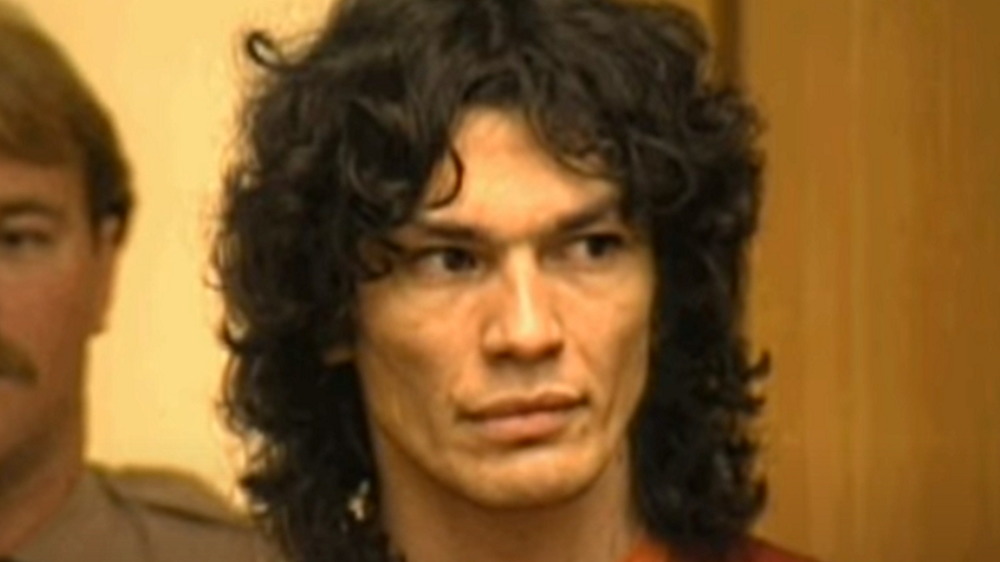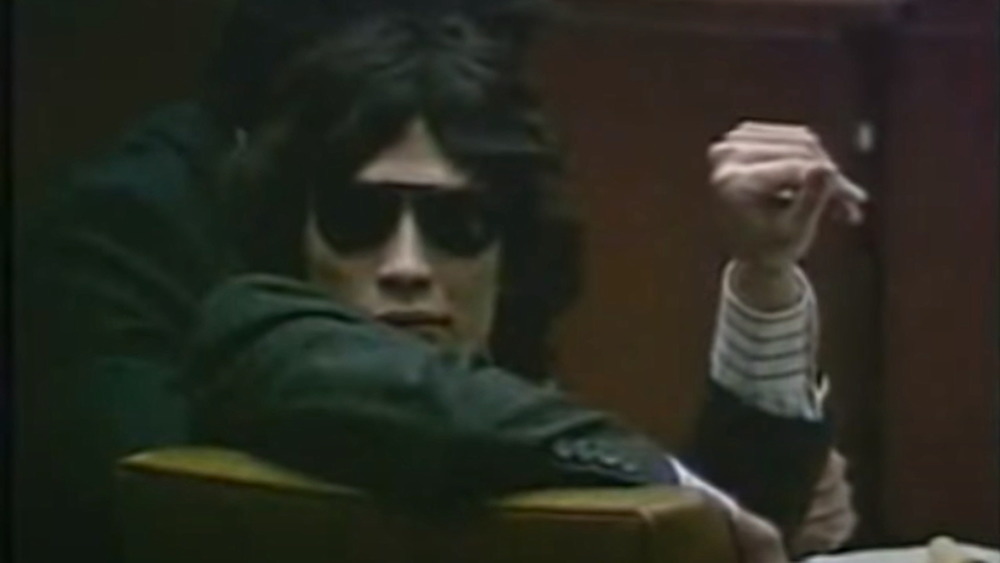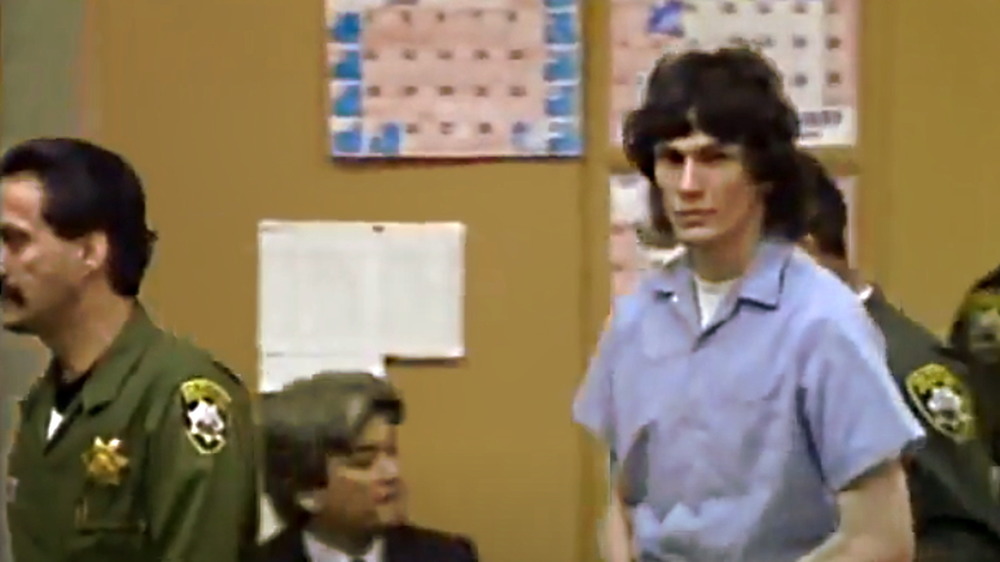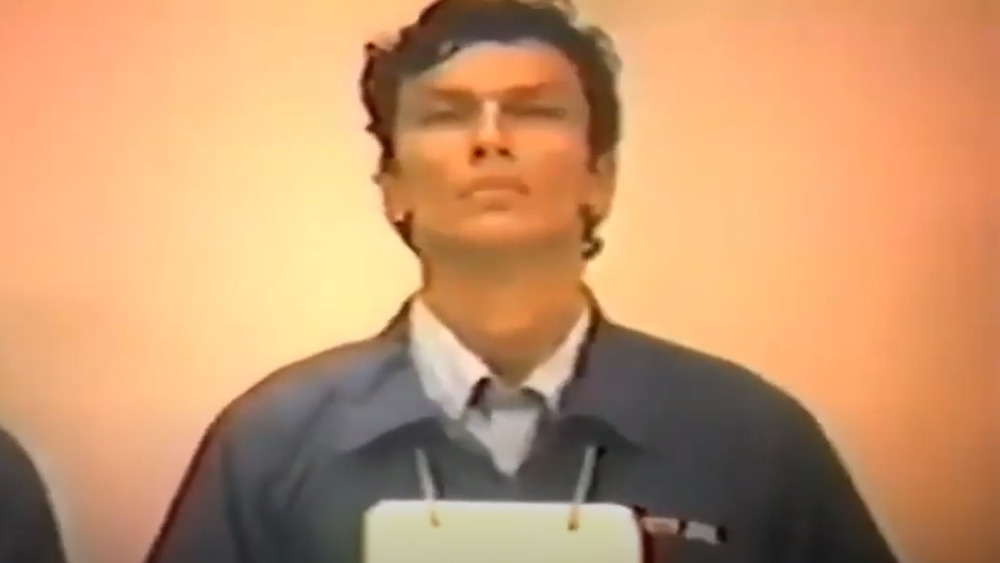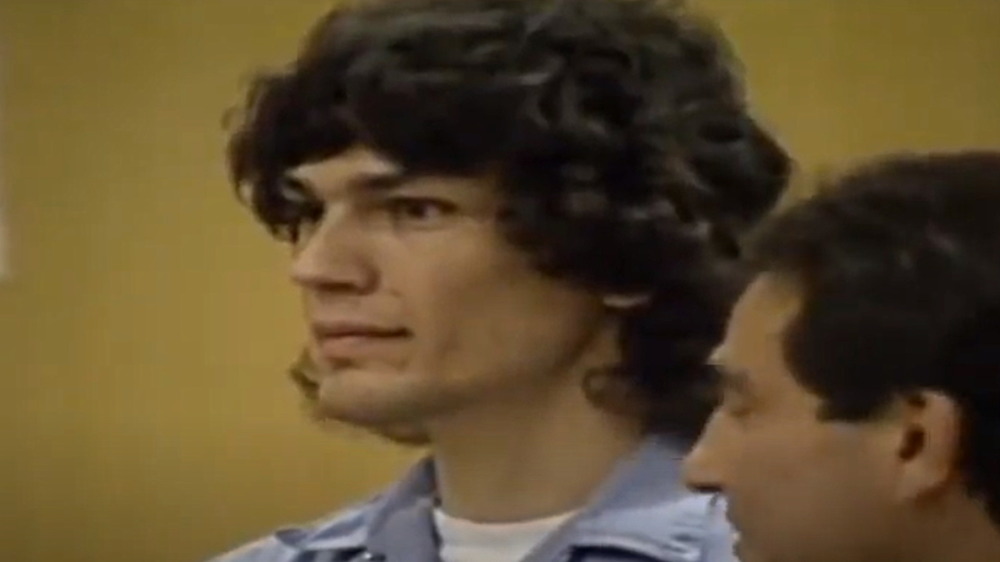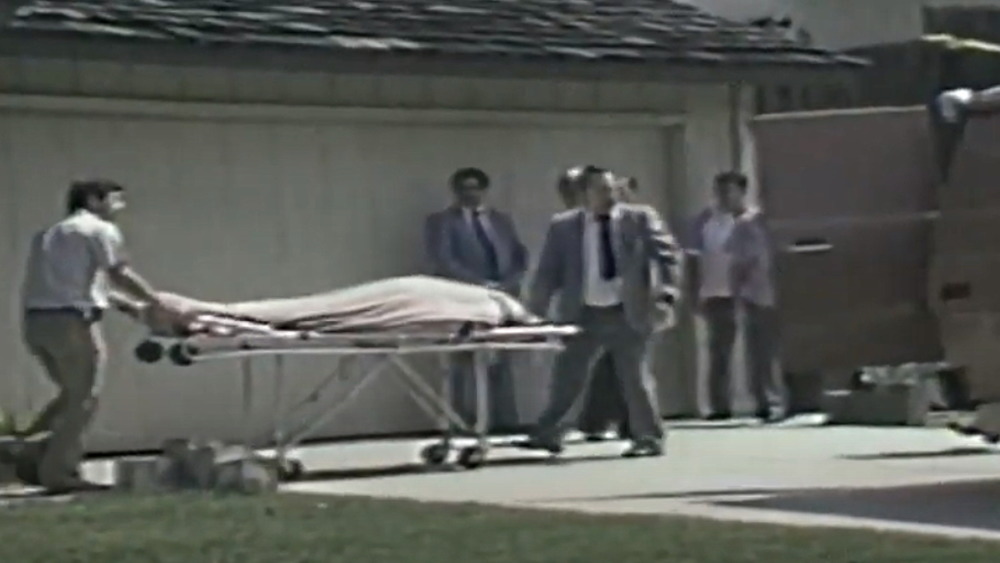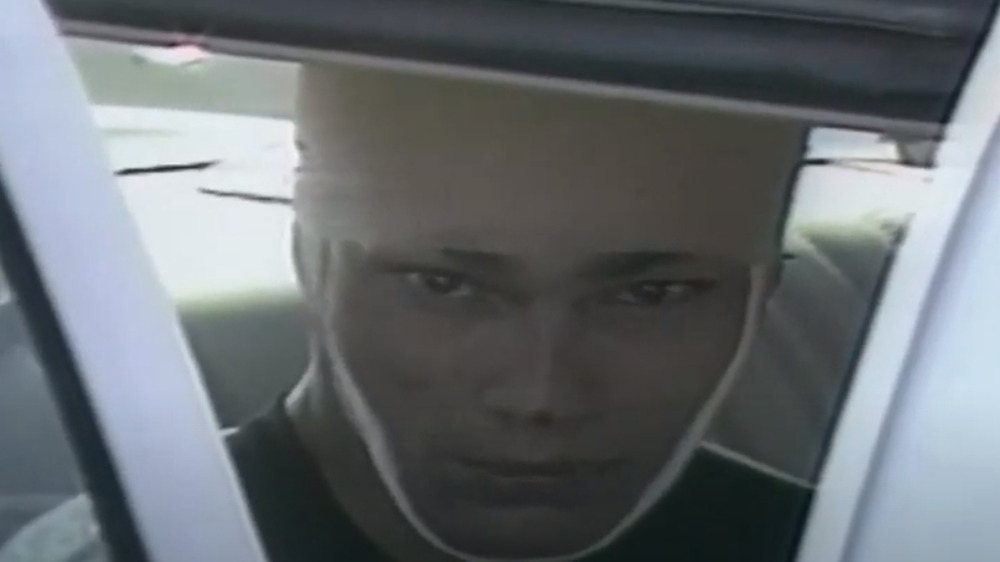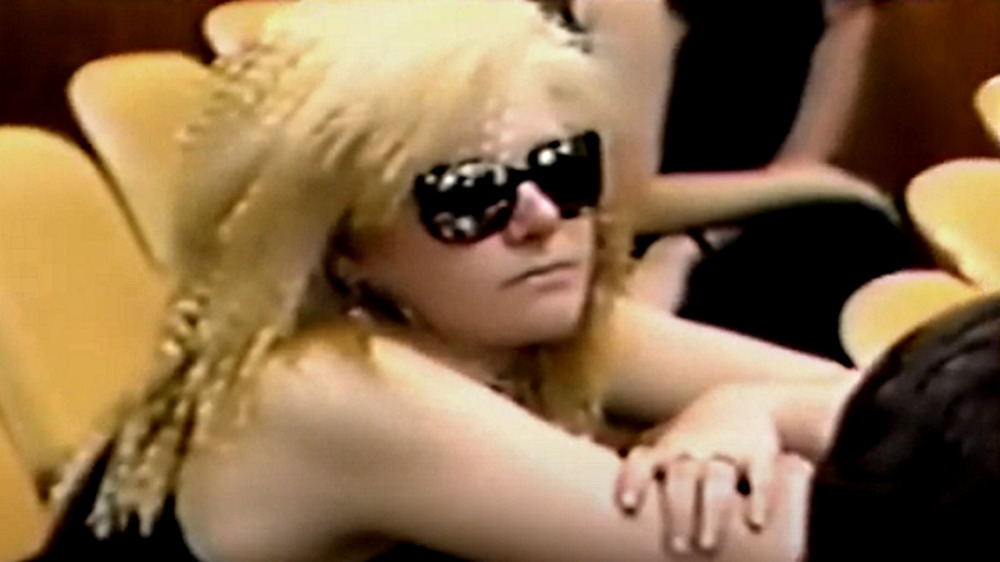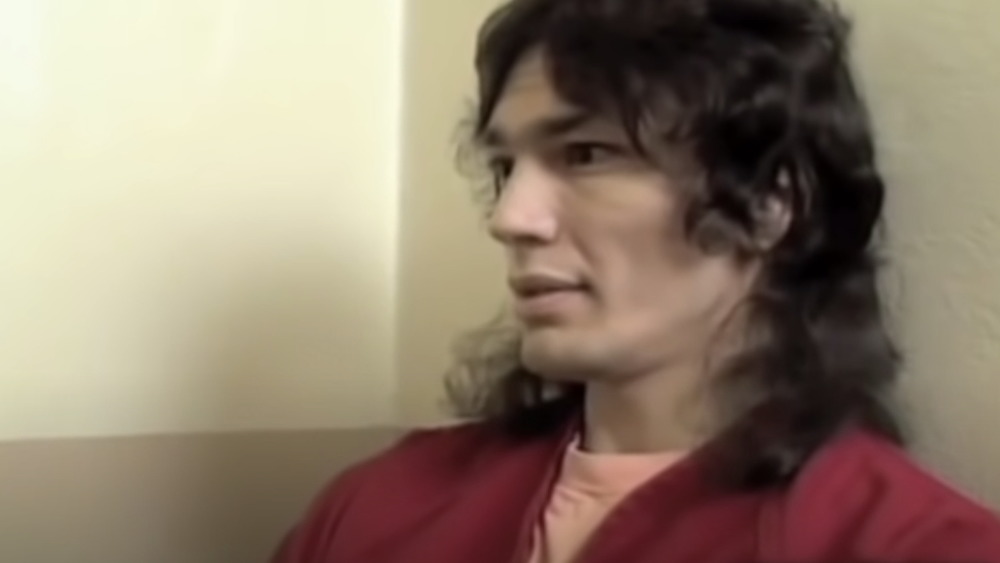The Messed Up Truth About The Night Stalker
The Golden State has seen more than its share of violent crime and serial killers in the last half of the 20th century. From Charles Manson to the Zodiac Killer, California seems to be a breeding ground for notorious psychopaths and murderers. Still, nothing could prepare the state for the brutality of a series of gruesome murders that gripped Los Angeles and San Francisco from June 1984 to August 1985.
With no apparent motive, the serial killer who would come to be known as the Night Stalker attacked in the dead of night, savagely assaulting his victims in their own homes and sometimes in their own beds. Men, women, and children ranging in age from nine to 81 fell to the mysterious killer.
With each murder, the Night Stalker became bolder. Often, he left behind the mark of the inverted pentagram, a symbol long associated with Satanism. Those lucky enough to survive his attacks described a figure out of hell itself — a slender phantom in black with rotting teeth who reeked of wet leather.
Eventually, the Night Stalker's luck ran out. The killer was no demon from the depths. He was a 25-year-old drifter from El Paso, Texas, named Richard Ramirez. A self-styled devil worshipper with a penchant for sexual assault and a love of heavy metal, Ramirez was brought down by the very community he had terrorized. This is the horrifying true story of the Night Stalker.
Richard Ramirez's bizarre childhood
Richard Ramirez was born Ricardo Leyva Muñoz Ramírez in El Paso, Texas, on Feb. 29, 1960. His father, Julian Ramirez, a former police officer, was a stern man who had been physically abused by his father and grandfather and visited the same treatment on his four sons. As recounted in The Night Stalker: The Life and Crimes of Richard Ramirez, by Philip Carlo, Julian was also prone to turn his rage on himself. Richard once witnessed his father beat himself bloody with a hammer. To avoid his father's erratic temper, Richard often slept in a nearby cemetery.
A reclusive child prone to epileptic seizures, Richard became close to his cousin Miguel Ramirez, a decorated Vietnam veteran. Miguel regaled young Richard with violent tales and showed him graphic photographs of decapitations and war crimes. "Having power over life and death was a high," Miguel told his impressionable cousin. "You controlled who lived and who died — you were God." In 1973, 12-year-old Richard watched his cousin murder his wife with a .38-caliber pistol.
At age 13, Richard, unable to cope with his father's abuse, moved in with his older sister Ruth and her husband Roberto Avala. To Ruth's anger, Roberto, an obsessed peeping tom, took Richard with him on his nightly rounds of spying in the windows of neighborhood women. Under cover of night, Richard went beyond peeping and began breaking into homes just to see if he could enter and escape undetected.
Richard Ramirez's life of crime
Initially, Richard Ramirez's drug use was limited to marijuana, which he began experimenting with at age 10. He began to use the drug more regularly with his cousin Miguel Ramirez. Miguel's murder of his wife in front of 12 year-old Richard seemed to flick a switch inside the troubled youth. He never told his parents he had witnessed the killing.
Richard became more withdrawn and began getting into trouble at school. As recounted in Night Stalker: A Shocking Story of Satanism, Sex, and Serial Murders, by Clifford Linedecker, Richard's late night breaking and entering landed him in a youth camp for juvenile delinquents.
At 15, Richard managed to get a job cleaning rooms and carrying luggage at a hotel. After hours, he would skulk around the hotel, peeking in windows. Lecherous looks and flirtatious comments directed at female guests landed him in trouble with management. Nevertheless, he was deemed responsible enough to be given a pass key after three months on the job. He put it to immediate use by burglarizing rooms. Simple theft wasn't enough to sate his dark side, however, and he used the key to enter a woman's room intent on assaulting her. The guest's husband soon arrived and severely beat Richard before calling the police.
After two failed attempts at the ninth grade, Richard left school at 17 with no direction, a juvenile record, and reputation as a thief. Soon, he started using LSD, mushrooms, and peyote and believed he was developing a personal rapport with Satan.
Richard Ramirez becomes a killer
On April 10, 1984, 9-year-old Mei Leung and her little brother were playing in the apartment building where they lived in San Francisco's Tenderloin district. The little girl wandered off to the building's basement looking for a lost dollar. Minutes later, her 8-year-old brother stumbled upon the most horrific scene of his short life. Mei Leung's lifeless body was hung from a pipe. She had been repeatedly stabbed and strangled. "If you can picture Christ on the cross, that's the way she looked," former San Francisco police inspector Ronald Schneider told the New York Post in 2016. "Her head was drooped and her chin down. It was a sad sight to see. She kind of got to me."
Police, baffled by the lack of evidence, failed to identify a suspect, and the case went cold until 2009, when DNA evidence found at the scene was positively identified as belonging to Richard Ramirez. Mei Leung was likely Ramirez's murder victim. For over two decades, authorities assumed the Night Stalker murders began in June of 1984 with the slaying of 79-year-old Jennie Vincow. It is believed that Ramirez was likely in the basement looking for valuables to steal when Mei Leung stumbled upon him.
Thanks to modern forensic science, the mystery of Mei Leung's death was solved at last and the longstanding narrative of the Night Stalker upended. Still, other DNA found at the crime scene points to the possibility that Ramirez had an accomplice.
The first Night Stalker murder
According to author Philip Carlo, Richard Ramirez was coming down from a cocaine high and desperate for cash on the evening of June 27, 1984. He had spent much of the night cruising Los Angeles' skid row in a stolen car when he decided to take the 10 Freeway to Glassell Park, a neighborhood near Forest Lawn Cemetery. Searching for a house to rob, he settled on a shabby, pink apartment building.
His target was the first floor apartment of 79-year-old widow Jennie Vincow. Vincow had moved to Los Angeles from Bensonhurst, Brooklyn, just three years prior at the request of her son Jack, a recently unemployed pharmacist, who was concerned for her health. A dutiful son, Jack lived on the second floor where he could tend to his mother's needs.
Carefully surveying his surroundings, Ramirez donned a pair of gardening gloves and slinked across the building's small courtyard. Vincow's window was open with only a flimsy screen between her and her killer. Unable to pry the screen off, Ramirez removed his gloves to make the job easier. Slipping through the open window, he carefully searched the apartment. Enraged when he found nothing of value, Ramirez descended on Vincow as she slept. Brandishing a razor-sharp hunting knife, he viciously stabbed the elderly woman, bringing the blade down again and again with the fury of a man possessed. At last, he slashed her throat with such ferocity that he nearly decapitated her. The bloody reign of Night Stalker had begun.
The Night Stalker committed two murders in one day
According to crime writer Philip Carlo, Richard Ramirez bought a .22-caliber pistol off the street in March 1985. The small gun was perfect, Ramirez thought. It was easy to conceal and relatively quiet. Most importantly, it was the preferred close-range weapon of professional hit men. Although the gun had little in the way of stopping power at a distance, a point blank shot to the head was a guaranteed kill. Clad in his customary black, he pulled down his dark blue AC/DC cap. With his favorite band's Highway to Hell album blaring over his headphones, he stole a car from a nearby gas station and followed 22-year-old Maria Hernandez to her Rosemead, Calif., home.
Under cover of night, he followed Hernandez into her garage. Closing to a distance of two feet, he fired at her. The terrified young woman instinctively raised her hands. Miraculously, the small caliber bullet ricocheted off her keys. Lucky to be alive, Hernandez slumped to the floor and played dead.
Hernandez's roommate, Dayle Okazaki, 34, wouldn't be so lucky. Patiently waiting for her to move from her hiding place below a kitchen counter, Ramirez killed her with a single shot to the head.
Fleeing the scene in his stolen car, an emboldened Ramirez followed 30-year-old Tsai-Lian Yu onto North Alhambra Avenue. While stopped at redlight, Ramirez entered Yu's vehicle from the passenger side. The killer shot her in the side and back. Yu was pronounced dead on arrival at a nearby hospital.
The Night Stalker claims more victims
Believing he was working under the guidance and protection of Satan, Richard Ramirez went on a bloody rampage of assault, robbery, and murder throughout Southern California and San Francisco. Striking in the dead of night, Ramirez killed indiscriminately. The killer had no immediately discernible pattern or method in carrying out his murders, leaving behind few clues save for the mark of the inverted pentagram left at some of the crime scenes. Counting the early murder of Mei Leung, a total of 14 innocent lives would end at the hands of the Night Stalker.
Among the dead were 64-year-old retired accountant Vincent Zazzara — shot to death in his sleep. Ramirez tied and beat Zazzara's wife Maxine before shooting her three times and mutilating her body with a kitchen knife. In a final touch of depravity, Ramirez gouged out her eyes, placed them in a jewelry box, and claimed them as a grotesque trophy.
Many of Ramirez's victims were elderly. Sisters Mabel Bell, age 83, and Florence Lang, 81, came face-to-face with evil on May 29, 1985. Unable to locate a knife, he bludgeoned both women with a hammer and electrocuted Bell with a frayed electrical cord. Leaving his mark for the first time, the murderer scrawled a pentagram on Bell's body and bedroom walls with lipstick. Lying comatose for two days before being found, Lang survived in a vegetative state, but Bell soon succumbed to her injuries.
Satanic connections: the Night Stalker leaves his mark
As recounted in The Night Stalker: The Life and Crimes of Richard Ramirez, young Richard Ramirez's obsession with Satan began at an early age. Growing up in a devoutly Catholic household, Ramirez understood God, Satan, Heaven, Hell, and sin as concrete realities.
As Ramirez entered adolescence, his sexual fantasies began to focus on violence, bondage, and death. Yet, his dark thoughts inspired guilt born of his religion. Soon, he came to feel that Satan would approve of his secret self, and perhaps, the devil might be a more fitting deity for him to follow.
According to author Clifford Linedecker, Ramirez's fascination with Satan ironically intensified after attending a Jehovah's Witnesses' Bible study class with his friends Eddie Milam and Tom Ramos. Ramirez scoured the public library for books on the occult, learning all he could about Satanism and black magic. At some point, he stumbled upon the writings of the Church of Satan's Anton LaVey and made a pilgrimage to San Francisco to meet LaVey. "When I met Richard Ramirez, he was one of the nicest, most polite young men you'd ever want to meet," LaVey told the press in the wake of the killings.
Yet, Ramirez's brand of Satanism was a far cry from LaVey's theatrical atheism. By the time of the Night Stalker murders, he regarded Satan as a malevolent force to whom he was a willing slave. The more sadistic, depraved, and violent his acts, the more his evil master would smile on him and protect him.
The hunt for the Night Stalker
Although cautious, Richard Ramirez nevertheless left behind clues. Among the first was a single fingerprint left on a window screen belonging to victim Jennie Vincow. Unable to get a grip on the screen, Ramirez had removed his gloves.
He left behind a dark blue baseball cap emblazoned with the lightning bolt logo of his favorite band, AC/DC, at the scene of his attack on Maria Hernandez. Ramirez also left the print of his size 11-and-a-half Avia sneakers in dirt, mud, blood, and on the face of victim Joyce Nelson. Most critically, he left behind 15 battered survivors who could provide an accurate, physical description of the killer who made them "swear to Satan."
Initially, authorities believed that many of the murders were unrelated because of Ramirez's erratic, motiveless methods. Undaunted, lead detective Gil Carillo was certain he was on the trail of a serial killer. Ramirez, however, kept an eye on the local media. With the heat on in L.A., he headed for San Francisco. Bay Area police were temporarily hamstrung in their investigation when San Francisco mayor Diane Feinstein leaked details about the crimes to the press, including the shoe print evidence. Ramirez disposed of his Avias and headed back to L.A.
When a single fingerprint from the rearview mirror of a stolen car used by the killer was matched to Ramirez, the police knew they had their man. When his mugshot was released to the press, the Night Stalker had no place to hide.
A terrified community takes action
Back in Los Angeles after a failed trip to visit his brother in Tucson, Ariz., Richard Ramirez was unaware that he'd become the lead story on every newscast and newspaper in the city. While picking up a cup of coffee and pastry at a nearby liquor store, he noticed some elderly Hispanic women staring at him. He clearly heard one of them exclaim, "El matador! (the killer!)" Dropping his eyes to a newspaper rack, he saw his own face staring back at him. As he dashed for the exit, Ramirez formulated a plan. He'd steal a car, head for Mexico, and blend in.
As Ramirez ran, he noticed a crowd was giving chase behind him. Desperate for escape, he attempted to carjack Manuela Villanueva while she waited for her boyfriend, Carmello Robles, outside a bakery. Beaten away by Robles and barber Arthur Benevedes, Ramirez fled on foot, bounding over fences and running through backyards. He made two more attempts at carjacking. The second would be his undoing. When Ramirez pulled Angie De La Torre from her automobile parked outside her home, he met his match in her husband, Manuel. Brandishing a heavy, iron bar, Manuel struck Ramirez in the head. The killer wouldn't make it much further before the angry crowd descended on him, beating him with fists, feet, barbecue tools, and anything they could get their hands on. Fortunately for Ramirez, the police arrived to take him into custody. "I'm lucky that the cops caught me," Ramirez later said.
Richard Ramirez's trial
Because of the sheer volume of crimes involved in the Night Stalker case, it took two years before Richard Ramirez could be brought before the court for a preliminary hearing on March 6, 1988. His inexperienced attorneys, Arturo and Daniel Hernandez, delayed the trial for years with requests for postponement and pretrial motions. Jury selection for what would be one of California's most expensive trials at last began in July 1988.
During the delays, Ramirez consciously perfected his image as a bad boy outsider. He played the role of a rockstar killer to the hilt, flashing Satanic symbols to the courtroom, staring down the prosecution and jury, and praising Satan.
When prosecutor Philip Halpin completed his methodical presentation of the gruesome evidence, the jury convicted Ramirez of 13 counts of murder. Sentenced to die in California's gas chamber, Ramirez quipped, "Big deal. Death always went with the territory. I'll see you in Disneyland."
The Night Stalker's life behind bars
During and after Richard Ramirez's trial, the killer experienced a kind of adulation usually reserved for celebrities. The Night Stalker received thousands of letters from the curious and the lovelorn. Overwhelmingly, Ramirez's admirers were women. Attracted by his boyish looks and fascinated by the brutality of his crimes, a dedicated group known as "the women in black" attended his hearings and visited the murderer behind bars. "Everyone makes him look so bad," one of Ramirez's admirers told San Francisco TV station KRON. "I know that he's a nice person because I've met him..."
Ramirez's most ardent admirer, journalist Doreen Lioy, received 75 love letters from the serial killer over a period of 11 years. In 1996, she and Ramirez married. According to some sources, Lioy cut off contact with Ramirez when DNA evidence linked him to the 1984 slaying of 9-year-old Mei Leung. As of this writing, Lioy's whereabouts are unknown.
Cancer claims Richard Ramirez
On June 7, 2013, death claimed the Night Stalker. However, Richard Ramirez would not die in a California death chamber. Suffering from liver failure, Ramirez, who had become increasingly reclusive in his final years, was transported from San Quentin State Prison to Marin General Hospital. His deteriorating health manifested in his complexion. "He was the color green," an unnamed source told the New York Post. "He looked like a green highlighter pen. He was sitting up in his bed doing stretches."
As reported by USA Today, a report from the Marin County Coroner's office revealed that Ramirez was suffering from B-cell lymphoma, a deadly form of blood cancer. His autopsy also stated that a history of drug use and a hepatitis C infection also contributed to his death.
Ramirez was 53 years old at the time of his passing. With appeals still pending, he likely wouldn't have faced execution until he was 71.
